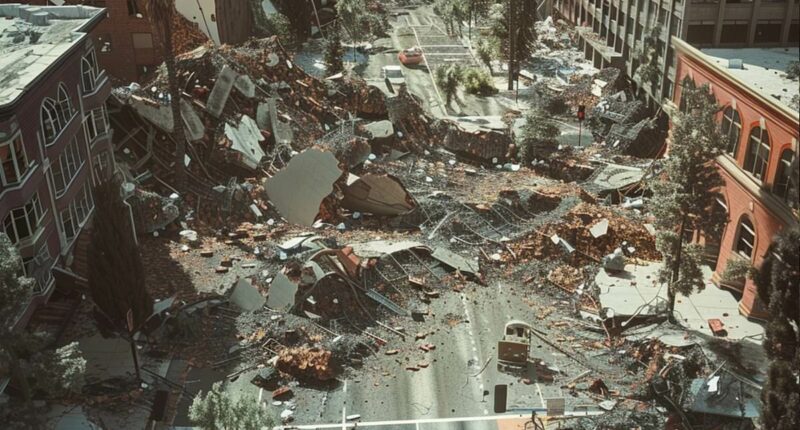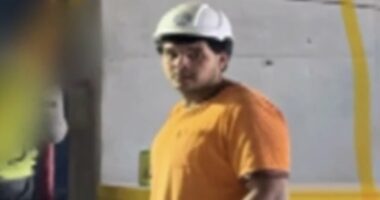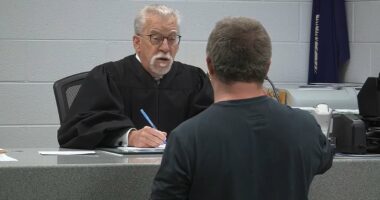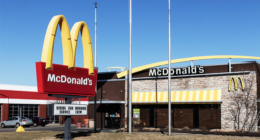Share this @internewscast.com
Residents of California may soon face the threat of deadly ‘supershear’ earthquakes. These rapid ruptures result in an intense shock front that is significantly more devastating than typical earthquakes, experts caution.
Professor Ahmed Ettaf Elbanna from the University of Southern California shared with the Daily Mail that the likelihood of California experiencing a supershear event in the near future is quite high.
This assessment was based on studies of California’s major strike-slip faults that showed an event like this is statistically likely.
According to Elbanna, these events cause prolonged and widespread violent shaking, potentially damaging buildings that would typically withstand lesser tremors.
Supershear events are considered particularly dangerous because they deliver a ‘double strike,’ first the shock front, then the rupture itself.
The shock front moves faster than usual seismic waves, hitting with an abrupt, powerful jolt comparable to a sonic boom, followed by extended shaking that stresses structures. These dual effects define the ‘double strike’ phenomenon.
‘Given that 70 percent of the population in California lives within 30 miles of an active fault, this… poses an extra risk,’ Elbanna said.
In supershear earthquakes, the fault line rupture speeds past surrounding seismic waves, channeling energy into a shockwave reminiscent of a sonic boom when a jet surpasses the speed of sound.

Though previously underestimated by scientists, the warning about supershear earthquakes is now urgent, with experts concerned they could cause unprecedented destruction (Stock image).
Beyond structural damage, Elbanna warned, critical lifelines such as power grids, transportation networks and water systems could be severely disrupted.
Internet and communications could remain down for ‘days or even weeks,’ he added, creating a particularly dangerous situation in what he described as ‘an already vulnerable political and information environment.’
Elbanna told the Daily Mail it is widely understood that California is overdue for a big earthquake.
‘We know it will be unlike anything the state has experienced in the past century,’ he said. ‘Lives may be lost, and damages could reach into the hundreds of billions of dollars.’
California has more than 500 active fault lines (the visible evidence of a fault on the Earth’s surface) and a total of 15,700 known faults (a three-dimensional break in the Earth’s crust where rocks on either side have moved relative to each other). The San Andreas Fault is the most prominent.
Hundreds of the state’s faults are considered potentially hazardous, including the San Andreas, San Jacinto, Newport-Inglewood and Hayward.
‘California is home to many long faults that are capable of producing large destructive earthquakes of Magnitude 7 (M7) or larger,’ Elbanna told the Daily Mail.
‘Our survey of M7+ earthquakes on strike-slip faults worldwide (similar to the ones listed) suggests that more than one third of these earthquakes showed characteristics of supershear ruptures.’
That included earthquakes in which the rupture moves faster than the surrounding seismic waves, producing a sharp, sonic-boom–like shock front followed by prolonged shaking.
The concern, he explained, is that supershear earthquakes remain ‘largely understudied.’
As scientists begin to recognize them more frequently, there is a growing need to understand the ‘extra hazard and risk’ they present, particularly in densely populated areas like California, where multiple active faults intersect and run close to major cities.
Researchers have also warned that the proximity of these faults increases the risk of ‘earthquake doublets,’ where a rupture on one fault triggers another nearby shortly afterward, potentially compounding the devastation.

California has more than 500 active fault lines and a total of 15,700 known faults, with the San Andreas Fault being the most prominent. Pictured: A map of California fault lines

More than 70 percent of California’s population lives near dangerous faults, including those in Los Angeles (pictured)
‘In a tectonic setting like this, it’s highly likely to expect that a supershear rupture could happen here. That doesn’t mean we need to panic, but it does mean we should be studying these scenarios carefully and planning for them.’
Supershear ruptures were first hypothesized in the 1970s, though many scientists dismissed them as theoretical.
Through the 1980s, skepticism persisted. By the 1990s, however, evidence began to emerge showing that earthquakes could indeed exceed the speed of shear waves – seismic waves that typically carry energy through the crust. (Speeds differ depending on the material the waves are moving through.)
The 2002 Denali earthquake in Alaska offered the first clear field recordings, confirming the distinctive signatures predicted by supershear models, including unusually sharp, high-amplitude initial jolts (shock fronts) followed by extended fault rupture shaking.
This phenomenon was also observed in parts of the devastating 2023 Turkey earthquake, where sections of the rupture moved at speeds of several miles per second – faster than the surrounding seismic waves.
That disaster was the deadliest natural event in modern Turkish history, killing more than 50,000 people, leaving 1.5 million homeless and damaging an area of 140,000 square miles.

Supershear earthquakes were behind the devastation in Turkey in 2023 (pictured)

The Indonesian earthquake in 2018 was a supershear earthquake (pictured)
Supershear earthquakes can cause unusually severe damage to buildings that might otherwise withstand typical quakes. They amplify shaking at frequencies of two to three cycles per second, which is the range most dangerous for short- and mid-rise buildings and stiff infrastructure.
In comparison, conventional earthquakes usually produce lower-frequency shaking that affects taller, more flexible structures.
While building codes account for concentrated bursts of shaking in one direction, they do not explicitly address the amplified ground motion parallel to a supershear fault rupture.
Elbanna said this gap underscores the urgent need to evaluate risk and update seismic design standards.
‘This means running realistic scenario simulations that include supershear ruptures and carefully characterizing the resulting shaking patterns and intensity,’ he explained.
He added that California should expand seismic monitoring near major faults to improve detection and response planning.

The 2018 Indonesian earthquake devastated large areas. Pictured: effects of the quake
Preparing for such an event, he emphasized, requires coordinated planning among scientists, engineers and government agencies.
Elbanna told the Daily Mail ‘preparing realistic mitigation strategies and resource allocation plans is critical’ for being ready if one of these mega quakes strikes.
‘We can prevent a natural hazard from becoming an apocalyptic disaster. But doing so will require scientists, engineers, policymakers, emergency managers and the public to work together in a coordinated effort to strengthen resilience.
‘This requires investing time, resources and expertise, but it is a necessary action that we can’t afford to ignore.’

















